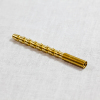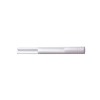As to cleaning vs not cleaning affecting accuracy, I plan to do another myth busting thread with my 10/22 barrel (3000 round count) and T/CR22 barrel (1000 round count) along with KSA bull barrel. So stay tuned.
I am more or less agnostic about the affects on accuracy of a cleaned or not cleaned barrel. A barrel that fouls, has lead lumps, I am sure would not be accurate, and for rimfires, the lube on the bullet, and case are critical. Incidentally, the 22lr is a very old round, and on match ammunition, very greasy from bullet tip to rim.
This is not an accident, these cases were externally lubricated all the way back, and the grease coating is critical for accuracy, and for function of semi automatic rifles and pistols. Rimfire semi automatic mechanisms are blow backs and the case must not adhere to the chamber. Based on discussions I had at this year's National Matches, rifle ammunition has a thicker, beeswax based lube, whereas the pistol match is covered with a thinner "vegetable" based lube. The reason, I was told, was the thicker lube increases cambering friction, and thus, causes misfires if the bolt is not fully closed. You can read in the brochures of match ammunition makers, about the "special lubes" they use for semi automatics. I have recommended oiling pistol rounds in cold weather, and this is a practice that Clark Guns recommends
However, testing the affect on accuracy of a cleaned barrel versus fouled barrel, if there is a difference, it might be less than the variability of the test ammunition. In which case, the test proves nothing. Commercial ammunition varies a lot more than match ammunition. Match shooters can send their rifles off to Eley or Lapua and have them lot tested in tunnels. I have done this at Lapua in Mesa AZ. Match shooters are consistently testing ammunition. A team shooter, who placed third that year, he said he had his rifle lot tested 60 or 90 times, might have been the 90 times. Ammunition accuracy varies by rifle, by lot, by brand. And if you find a particularly good lot, you buy all you can, and hoard the best for the big matches. I asked the third place shooter how many rounds it takes him to have confidence in his ammunition, and he said "a brick". And that is pretty close what it has take me to trust, or come to an opinion on a lot, about 500 rounds in competition. When I use my best lot selected ammunition my X count is always higher.
There is no wind in the test tunnels because 22 lr ammunition is extremely wind sensitive. Until you shoot rimfire accuracy sports, such as 22lr F Class, or Smallbore prone, you probably dismiss wind, because your centerfire rounds are much more insensitive to wind. But, wind is out there, even if you can't see it. Wind is not regular, it is not linear, there are pockets and bubbles, and swirls, and wind devils, even in what appears at first, flat calms. Many a time I have broken the shot, in what was a calm, only to see a flag flick, and that was enough to knock the bullet out of the ten ring. One little flick, no idea where those came from.
One of the worst are whirlwinds, they are little tornadoes. They are visible at Ben Avery, due to all the dust, and are locally called dust devils. But at an eastern range, not visible. Unless you look at the grass, and see moving circles! A whirlwind is a train wreck coming down the tracks. If you don't see it, lets say it blows your bullet out to the right, and then you make full left windage to correct, and then the other side hits your target, and blows the bullet out an equal amount left, plus the left windage you put on!




